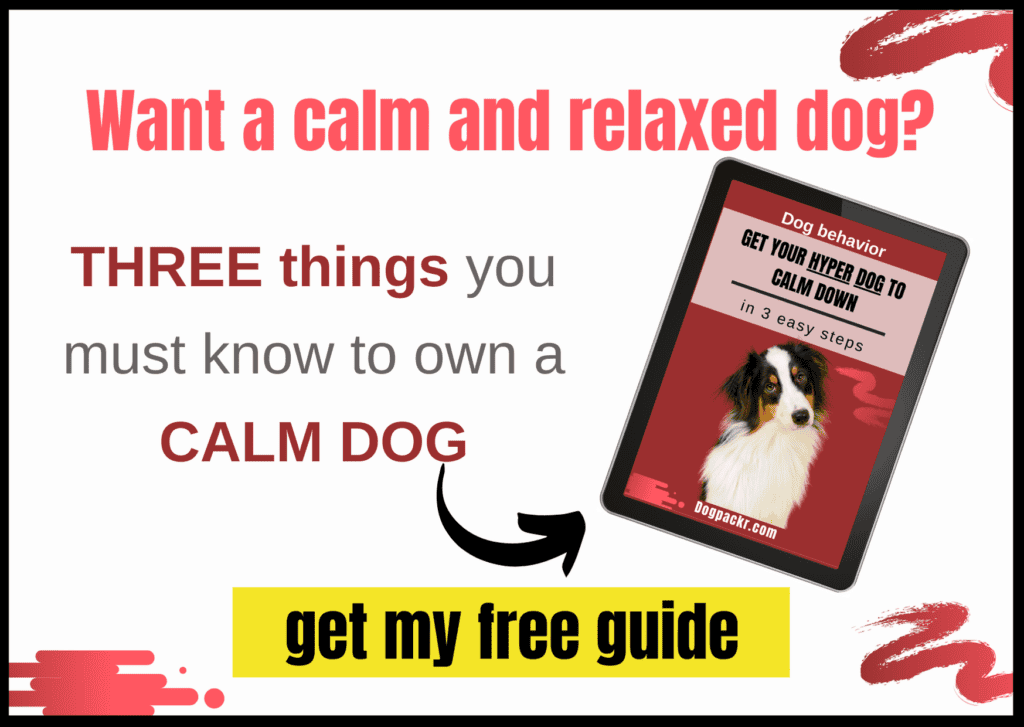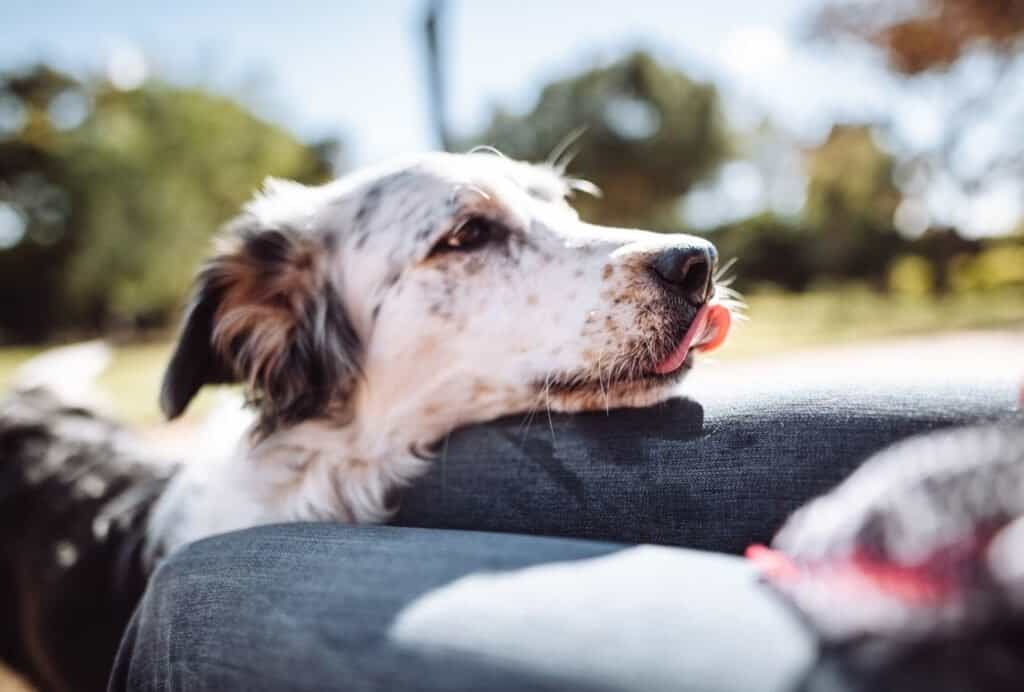
Is your house a mess whenever you leave your dog home alone?
Maybe the whole couch is chewed up or you have scratches on doors and walls. Or maybe you occasionally even find a puddle of urine or even some poop.
Maybe your house is till whole, but your neighbors are annoyed because your pup was barking or whining non-stop.
Well, if any of this rings a bell, your dog likely suffers from separation anxiety.
My dog Baloo suffered from very severe separation anxiety right from the start. He would show at least half of the signs and was clearly very stressed whenever he thought I was leaving.
With lots of training, patience and love he’s now doing fine. But it took a while…
While the reasons aren’t always that easy to understand, it’s pretty easy to spot the signs. So, in this article I’ll show you the 9 most common signs and symptoms for separation anxiety in dogs.
Along with that we’ll also cover what you can do about it, of course. Be prepared for some intense training. But if you follow the advice in this article, it will eventually get better, I promise!
Table of Contents
Separation Anxiety in Dogs
You’ve probably seen the term “separation anxiety” being thrown around, but what exactly is it?
In short, separation anxiety is when your dog becomes upset if he is separated from you. Separation anxiety can be very distressing for both you and your dog. Your dog might even become destructive when you’re away from him.
There are several signs that might indicate that your dog has separation anxiety. But first, let’s talk about why your dog is experiencing this problem.
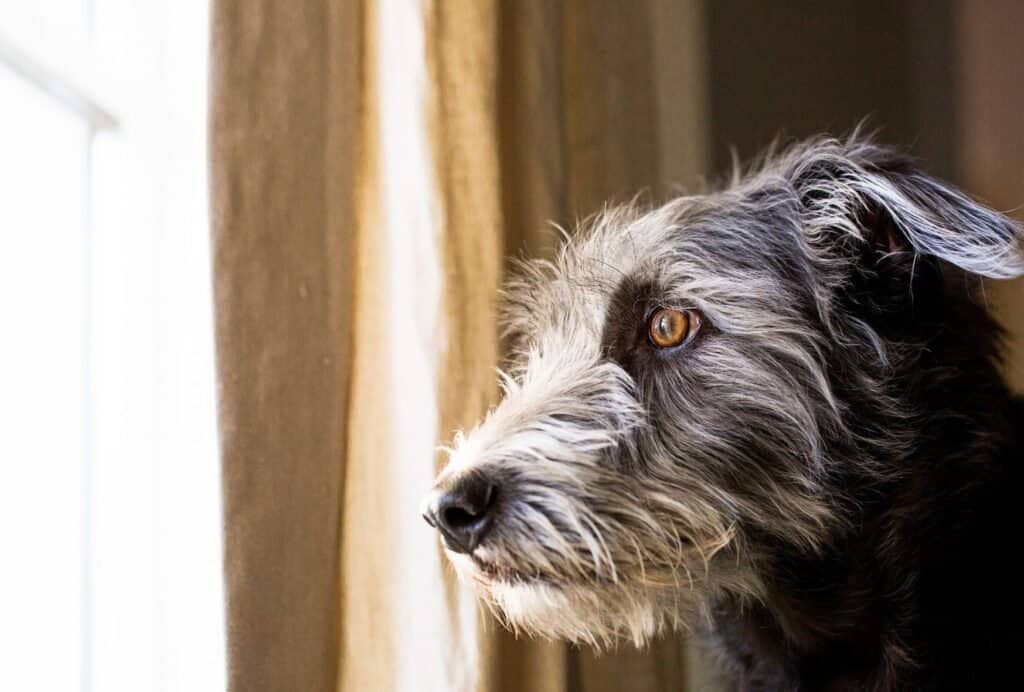
What Causes Separation Anxiety in Dogs?
There is no one thing that causes separation anxiety, and no one is 100% sure what exactly gives a dog separation anxiety.
There are, however, some ideas.
One idea is that changes in ownership can trigger separation anxiety in dogs. Dogs that come from shelters seem to be more prone to developing separation anxiety.
Sudden, major changes seem to be one of the biggest factors when it comes to dogs developing separation anxiety. Someone suddenly missing from your dog’s house might also cause feelings of separation anxiety in him, as can moving to a new location.
Drastic changes in your dog’s schedule might also trigger it, especially if it means he’s home alone more often.
If you’ve noticed your dog acting out more, especially when you’re getting ready to leave, consider what his own schedule is. Have you gotten a new job that means your away from home more often? That could be the reason for his anxiety.
Why Does It Affect Some Dogs More than Others?
There are a lot of factors that play into whether or not a dog develops separation anxiety. Remember, every dog is different!
As we know, dogs that come from shelters tend to be more prone to struggling with separation anxiety than those come from a breeder, for example.
A dog’s breed might also have a role to play in this condition. Dogs were bred to be close companions for us, and some breeds tend to be clingier than others.
How Long Does It Take a Dog to Get Over Separation Anxiety?
It would be nice if there was a universal answer to this question. Separation anxiety can be frustrating, upsetting, and even dangerous for your dog. It can also be very hard on you emotionally.
Unfortunately, there’s no one-size-fits-all answer as to how long it takes a dog to get over separation anxiety. Every dog is different, and it depends on the severity of his anxiety, and how much time you’re able to put into helping him.
One thing to understand here is that you shouldn’t expect your dog to get over his anxiety on his own. Ignoring the problem, or letting him work through it by himself will actually most likely make the problem worse.
Before we get into the symptoms, here is one more very important reminder: your dog’s separation anxiety isn’t your fault!
Many dog owners whose dogs struggle with this problem blame themselves, and think they are bad dog owners. But that couldn’t be further from the truth! There are so many factors that go into dogs developing separation anxiety, and you’re not a bad dog owner if this happens to your dog!
I got Baloo from a breeder and he came with separation anxiety right from the start. It took us several months or maybe even a year until he was able to stay alone and be fully relaxed…
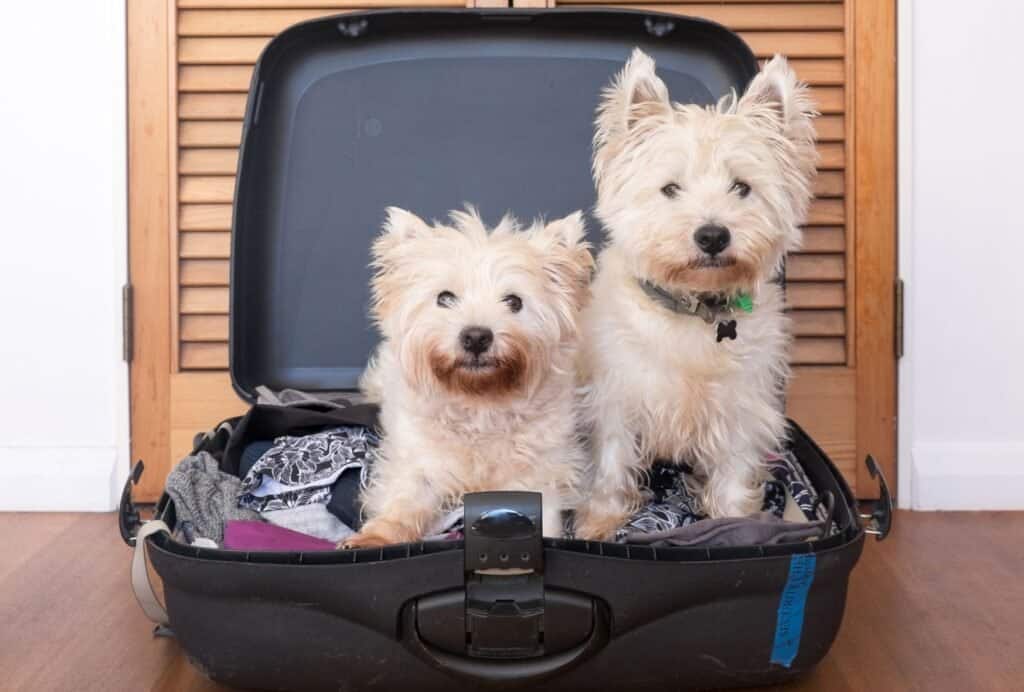
9 Signs and Symptoms of Separation Anxiety in Dogs
Now that we’ve talked about why some dogs get separation anxiety, let’s talk about what the signs and symptoms of separation anxiety are.
Of course, you might be wondering how exactly to tell if your dog is showing some of these behaviors. After all, you’re not in the house—that’s why it’s called separation anxiety, isn’t it?
The easiest way to know is to set up a camera and filming your dog while you’re away. This way, you’ll be able to see exactly what he’s doing while he’s by himself.
1. Getting Stressed When You’re About to Leave
If your dog has separation anxiety, he’s probably learned to pick up on the cues that tell him you’re about to leave. This might be picking up your bag, grabbing your keys, or even just standing by the door.
Once your dog notices these cues, he might start showing anxious behaviors. This can include shaking, drooling, panting, or whining while you’re getting ready to go. He might also follow you very closely and acting clingy.
For more information on clingy dogs, check out my previous article about why your dog is so clingy.
2. Barking or Howling
One of the ways dogs communicate with us and with each other is by being vocal. Dogs bark or howl to warn us, greet us or, in this case, to tell us they are feeling distressed.
If your dog tends to bark or how a lot when you leave the house, that’s a big sign he might have separation anxiety. This is especially true if it’s for prolonged periods of time.
Excessive barking and howling aren’t just distressing for you and your dog—it can be distressing for your neighbors who have listen to it while you’re gone!
If you’re wondering whether dogs get tired of barking, check out this article.
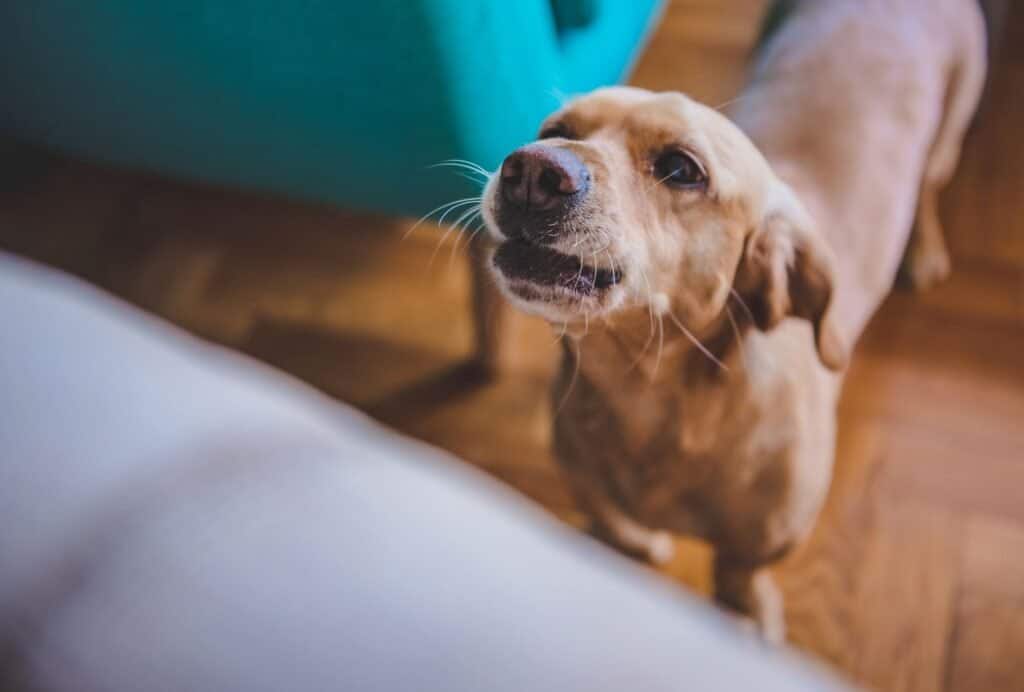
3. Crying or Whining
Crying or whining is a huge sign that your dog is distressed for some reason. If your dog is struggling with separation anxiety, he’ll probably whine or cry if he notices you getting ready. He’ll also whine and cry while you’re gone.
If you’re crating your dog and he starts whining when you leave him alone, you might be wondering how to help him feel safe and comfortable in his crate. Here are 7 tips to stop your dog from whining in his crate.
4. Chewing
Another big sign of separation anxiety is that your dog becomes destructive. If your dog is struggling with anxiety when you leave, he might channel that anxiety into chewing.
And we’re not talking about chewing up his toys here. If your dog has separation anxiety, he’ll chew furniture, clothing, even the wall! Your dog is doing this to try and comfort himself, and relieve himself of the stress that your leaving has caused him.
If your dog’s chewing is because of his separation anxiety, he’ll be more likely to do it when he’s left alone. So if you’re coming home from work to a chewed up house when he normally doesn’t chew anything, that’s a big sign he has separation anxiety.

5. Digging
Just like chewing, digging is a sign of destructive behavior caused by separation anxiety. Digging can be a self-soothing activity for your dog, and his way of coping with his anxiety.
On the other hand, digging can also be an attempt to escape his crate or your house in more extreme cases of separation anxiety. More on that later.
Digging can be a very intense behavior for some dogs. In very extreme cases, they may dig so hard that they make their paws bleed.
If you’re worried about your dog’s digging habits and want to help him stop, here is some advice for how to stop your dog from digging holes.
6. Pacing
Just like humans, dogs might start pacing when they get anxious or stressed. Your dog has so much nervous energy it’s hard for him to sit still.
If your dog has separation anxiety, he might start pacing while he watches you getting ready to leave. He’ll also likely pace around the house while you’re gone.
This is when a camera will come in handy. If you set up a camera before you leave, you’ll be able to see if your dog spends a huge chunk of his day pacing around the house.
7. Trying to Escape
In some very extreme cases of separation anxiety, your dog might start trying to find an escape route so he can chase after you.
If you’re finding scratch marks around your doors, your dog is probably trying to dig his way out. Some dogs struggle to even be alone in the yard by themselves, and might dig at or try to jump over your fence in an attempt to escape.
Check out my other article about how to stop a dog from digging under your fence, if that sounds familiar.
8. Excessive Drooling or Panting
Drooling and panting are really common signs of stress in dogs. It’s normal for your dog to pant and drool a little bit. But if he has separation anxiety, he will be panting and drooling a lot.
Some people find that their dogs leave entire puddles of drool when they leave them alone. Not only is this a major sign that your dog is seriously distressed by you leaving, but it’s also really gross to have to clean up!
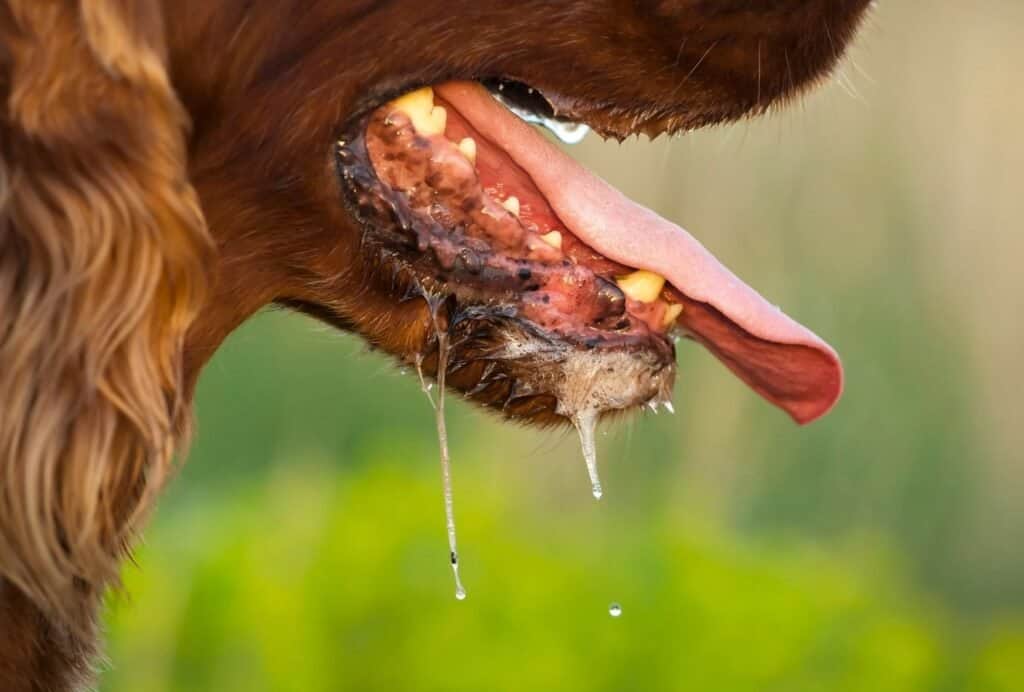
9. Urinating and Defecating
If your dog is perfectly housetrained but seems to be having accidents when you leave the house, that’s an indicator he has separation anxiety.
Dogs that are super anxious will often drive themselves to the point of defecating or urinating in the house, even if they’re fully housetrained. This behavior might be especially upsetting and frustrating for you.
And if you thought cleaning up your dog’s drool is gross, cleaning up his pee and poop inside the house is even worse!
Keep in mind that if your dog is urinating or defecating inside the house while you’re home, that’s likely a sign of a different problem. He might not be as housebroken as you thought, or he may need to go to the vet to rule out any medical issues.
It could also be an issue with submission. To learn more about this problem, here are 13 tips to stop excited or submissive dog peeing.
Training Tips for Your Dog’s Separation Anxiety
Separation anxiety can be difficult to manage, but there are ways you can train and help your dog.
Remember while you’re working with your dog to be patient with him and with yourself. And it’s worth repeating that his separation anxiety isn’t your fault!
Make Sure He’s Tired Before You’re Leaving
No doubt you’ve heard the saying “a tired dog is a good dog” before. And trainers and owners say this for a reason!
Too much energy can cause a lot of behavioral problems in your dog, so it’s important to make sure he gets enough physical and mental stimulation every day.
This might mean taking him for more walks or jogs, or getting him involved in dog sports. Dog sports are really great ways for your dog to build strength, confidence, and for the two or you to bond.
If you can’t make it outside for your regular walks, try to tire out your dog indoors.
And remember to incorporate lots of brain games into your dog’s life too! For more information and some fun things to try with your pup, here is how to mentally stimulate your dog.
Mental stimulation can also be a wonderful training tool if used correctly. Check out Braintrainingfordogs to learn how to train your dog to be the best dog he can be by using mental stimulation! Or have a look at Dogpackr’s review first to see if it’s a fit for you and your dog!
Desensitize the “Leaving Cues”
Desensitization and counter-conditioning are really important parts of training your dog when it comes to anxiety.
Doing this involves removing whatever stimulus is making your dog anxious, and then reintroducing it gradually and in a controlled way to help desensitize him to it.
As you work with your dog, he will be less stressed out by your leaving cues like picking up your keys or putting on your shoes. He’ll start to understand that being alone is okay, and that you leaving the house isn’t scary.
Here’s a good explanation of how to go about that:
Train Leaving Him Alone in Very Small Steps
When it comes to actually leaving your dog alone, you’re going to want to train him in small steps.
Start by leaving him alone for a just a second, and then coming back again. Then you can try leaving him for 2 seconds, then 5 seconds, and so on.
Make sure to always return before he starts crying or acting out and don’t make a big fuss. If you only come back when he’s crying, that teaches him that crying is what brings you back to him. And that’s the opposite of what you want!
And I actually found it works best if I don’t even praise him when I come back. Me leaving and coming back is just a normal thing, nothing to be scared or excited about.
Conclusion
Separation anxiety can be an incredibly difficult problem to deal with. And not just for your pup—but for you, too! That’s why it’s important, if you notice your dog showing signs of separation anxiety, you should intervene right away. This way you can take care of the problem before it becomes even worse.
As you’re working with your dog, remember that it’s important to be patient with your dog and with yourself. And remember, your dog’s anxiety isn’t your fault! The fact that you read this article so that you can help him shows how much you care about him.
P.s.: Don’t forget to check out Braintraining4dogs if you want to take your dog training game to the next level. It offers a 60-day money back guarantee, so you have nothing to lose.
*Disclosure: This post may contain affiliate links, meaning, I get a commission if you decide to make a purchase through one of my links, at no cost to you.

